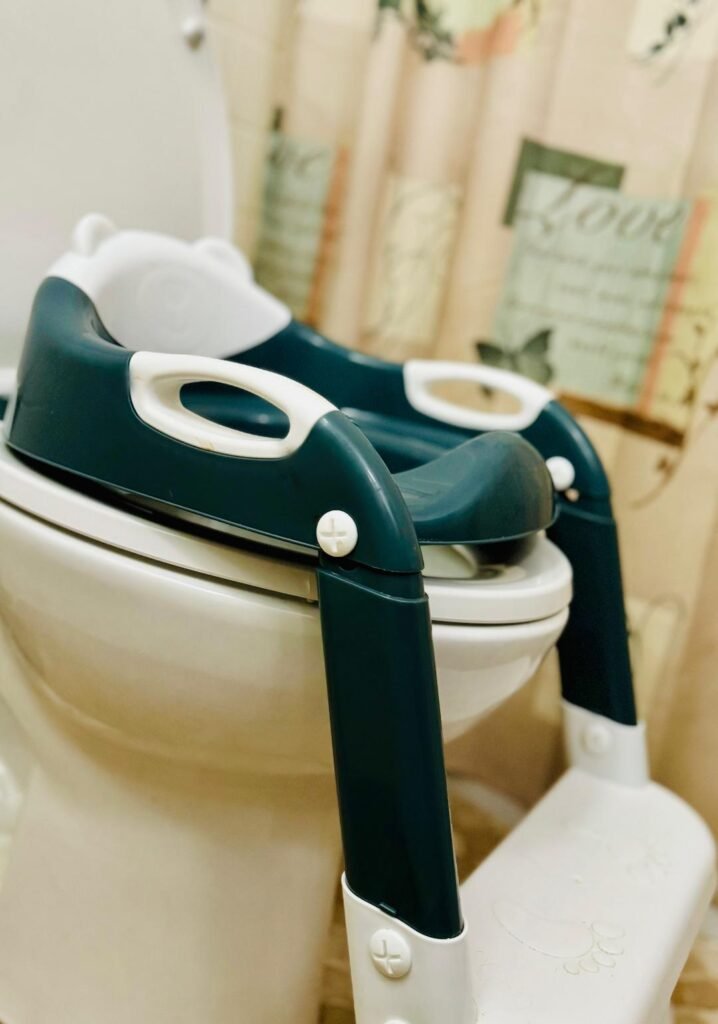If you have ‘mom guilt’, guess what? You’re not alone!
I was a preschool teacher who quit work to stay home with my son, and he is 3 and STILL not potty-trained (and I worked with 2-year-olds that yes, I helped to potty train)!
Talk about feeling like a failure!
Did I mention I have a degree in Psychology? And that I raised my special needs nephew? I’ve had more education in child development and experience teaching young adolescents than the average person.
And I still struggled to potty train my own child.
Somehow, someway, I hit a brick wall and those things don’t budge.

If you’re in the same boat as me, then let’s learn together how to help our little one’s over the potty hurdle. I’m focusing on boys because they have to learn to sit and stand, however, these tips can help girls as well, so please, read on!
There are no hard and fast rules to follow—it’s really just trial and error. Everything in this post is methods used at the preschool I worked for and from my personal experience.
Only start when they’re showing signs of being ready! This means:
- Showing interest in bathroom habits
- staying dry for longer periods
- discomfort with dirty diapers, and communicating the need to go
If they’re not showing interest, do not force it. Simply encourage in a positive manner.
Make sure it is not a stressful time in your toddler’s life, such as gaining a new sibling, moving, vacation, or major holidays. You will also want to set a stable daily routine in advance so that everyone in your child’s life can be on the same page. Consistency in multiple environments is important.
Everybody needs to jump in the boat and row!



- Supplies you will need:
• Potty chair or toilet attachment seat
• training pants and underwear
• cleaning supplies to sanitize (Clorox wipes often help)
• rewards you choose (stickers, small toys, or a favorite treat) - Introduce them to the potty:
• Explain the process
• Let them observe others using the toilet
• Read books or watch videos about potty training
• Be consistent on the terms you use
• Break down the process in a way they understand—“put pee pee in the potty” etc. - Establish routine (something like this):
Wake up—go potty
After breakfast—go potty
After drinking a full cup—go potty
After lunch—go potty
After nap—go potty
After supper—go potty
Before bedtime—go potty
- Essentially, your child should be trying the potty ABOUT every 45 minutes (can vary from every 15 minutes to 1 hour for each child). Use a timer on your phone if it helps—it did for me!
Okay, you get the idea.

- Transitioning from diapers to pull-ups
• Keep lighthearted and use enthusiasm
• Do in baby steps (use training underwear during day, diapers only at night) - Approach
• Attitude absolutely will make or break your child’s success!
• Be patient and NEVER punish accidents.
• Use positive reinforcements and rewards. - Appropriate Rewards
Positive Reinforcement: Definition, Theory, & Examples – The Berkeley Well-Being Institute (berkeleywellbeing.com)
• The Berkeley Well-Being Institute defines positive reinforcement as “the process of increasing the future probability of some behavior by following that behavior with a pleasant or desirable consequence”.
• Don’t make this complex! Keep it simple with things your child likes like:
Stickers
Small toys
Candy
Favorite treat
• When they grow bored with that reward, feel free to change it up!
• If you reward randomly, like every 2 or 3 times, that helps keep them from agreeing to try solely to get the reward.
• Praise if they try but can’t go, encourage them to keep trying, and remind them of the reward they receive if they are successful
• Reward only when they succeed
Tips for Boys
- Start with him sitting every time
You might assume you first train a boy to stand to potty and build up to sitting for bowel movements. It makes bowel movements less intimidating if he’s already sitting for urination and this way he can always get his pee in the potty, even if you aren’t around a smaller toilet or have his potty chair on hand. - Floating targets
If your little guy is tall enough and able to stand, use tiny floating targets such as Cheerios to make it fun for him while teaching him to aim. This can be done later, after he’s mastered sitting to go. - Utilize male role models
A mother can teach her son, but Dad or Grandpa (any older male role model) can sometimes be the better encouragement your boy needs to get motivated.
Challenges I faced training my son
- Constipation
Because of fluctuating constipation issues, it has been especially difficult to catch when my son needs to make a bowel movement. Sometimes, when his body is doing what it should, he might try to go hide to pass stool and we can rush him to the bathroom. Other times, when he has been given MiraLAX he will go before really realizing he needed to.
I sought medical advice from our pediatrician, who advised:
• upping his water intake
• encouraging fruits into his diet
• taking MiraLAX whenever constipation occurs
This helped. Having him sit every time has also helped with consistency.
It takes a lot of patience and understanding, so strap in, folks. It’s a marathon, not a sprint.

- Emotional Challenges
Some kids can roll with the punches and keep going effortlessly. Some kids not so much. My son falls into the latter and for those of you who also struggle with this, you are not alone!
Isolating the root cause of the problem helps significantly. Some examples:
• Fear of loud noises
• Lack of control
• Budding sense of autonomy and independence
• Power struggle dynamic
Parents sometimes struggle to curb their own emotional response to their child’s behavior, punishing them without pausing to investigate the WHY? of their behavior.
We do not excuse undesirable behavior, but it helps to appropriately respond to a behavior or action when we understand what is driving it. - Speech delay
Emotional readiness for potty training can often be influenced by whether they have met their communication milestones. My husband and I expressed concerns multiple times with our pediatrician, but only recently was an ENT able to confirm our son desperately needs his tonsils/adenoids removed and has been hearing everything as if his head is under water from fluid buildup.
While waiting for our son to have surgery, trying to understand what he is trying to communicate has been its own strange game of charades. It takes a little more effort in this case to potty train, but I encourage any parent to pursue speech therapy if there are any concerns.
We’ve seen a HUGE improvement once we finally got in with someone! - Nighttime potty training
This is only possible if your child has a bedtime routine and sleeps through the night. Our son wakes up multiple times every night. Our son has had issues with breathing, swallowing, and sleep disturbances due to the large tonsils/adenoids.
We had little chance to work on potty training through the night as our son mostly sleeps in our bed because of his persistent sleep disturbances.
This is your cue to rule out any medical issues and implement night routines before working on nighttime potty training.
In the end, it’s not necessary to make your head spin reading the hundreds of books, blogs, and studies on potty training. Confronting it without fear and using consistency, patience, and a positive attitude are the most vital things when beginning this journey with your kiddo. You’ve got this!
